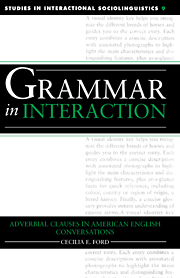Book contents
- Frontmatter
- Contents
- List of illustrations
- List of tables
- Acknowledgements
- Transcription conventions
- 1 Introduction
- 2 Overview of the conversational corpus
- 3 Initial adverbial clauses
- 4 Final versus initial adverbial clauses in continuous intonation
- 5 Final adverbial clauses after ending intonation
- 6 Comparison of clause types and apparent deviations from the general patterns
- 7 Conclusion
- Notes
- References
- Author index
- Subject index
6 - Comparison of clause types and apparent deviations from the general patterns
Published online by Cambridge University Press: 09 November 2009
- Frontmatter
- Contents
- List of illustrations
- List of tables
- Acknowledgements
- Transcription conventions
- 1 Introduction
- 2 Overview of the conversational corpus
- 3 Initial adverbial clauses
- 4 Final versus initial adverbial clauses in continuous intonation
- 5 Final adverbial clauses after ending intonation
- 6 Comparison of clause types and apparent deviations from the general patterns
- 7 Conclusion
- Notes
- References
- Author index
- Subject index
Summary
In the preceding chapters, I have explored the work that adverbial clauses do in conversation, and in what positions they do that work. In addition to the usage patterns focused upon in chapters 3–5, there is interesting variation in the distribution and functions of the three major types of adverbial clauses found in the corpus. In the present chapter, I compare the placement and functions of the different clause types, and I also highlight some apparent violations of the general principles discussed in previous chapters. The exceptions serve to further elucidate the principles themselves.
Different clause types in initial versus final placement
Examining variation in the use of different clause types, we find that causal clauses, while not appearing initially, do frequently appear in final position after continuing intonation. In final position, causal clauses do work that is distinct from the work of other final adverbial clauses. These differences are consistent with the semantics of the different clause types, causals presenting explanatory or motivating material, rather than temporal or situational grounding.
As can be seen from Figure 1, of all temporal clauses, most (52.5%) appear finally after continuing intonation. That is, a majority of temporal clauses in this corpus are being used to complete main clause meaning, rather than to structure the discourse (or add more material after an utterance is finished – to be discussed in section 6.2). Utterances in these conversations, then, seem to be regularly provided with some temporal or situational grounding through temporal clauses.
- Type
- Chapter
- Information
- Grammar in InteractionAdverbial Clauses in American English Conversations, pp. 131 - 145Publisher: Cambridge University PressPrint publication year: 1993



